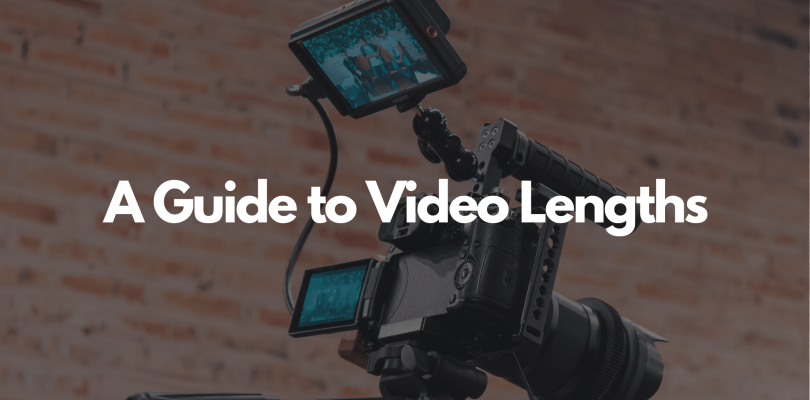Time is a valuable commodity. It is a non-renewable resource and one that we should treat with the utmost care in business. When it comes to video content, time is a factor not just for efficient production, but also for how many precious minutes we can expect our audience to commit to our materials.
There are general good practices for how long marketing videos should be based on the type of content they offer. However, there’s a lot more that we need to take into consideration when determining the optimum length for our videos. We have to seek to understand how length can have an impact on our intended audience, and how to strategize this to get the most out of both our resources.
Let’s take a deeper look at how video length features in our time-based economy. What factors must we consider while planning production? Which tactics can help us to squeeze optimum value out of every second?
Audience Needs
One of the first ports of call for any business is a deeper understanding of its consumers. After all, without adequate research into their needs and preferences, you are likely to be wasting resources on a product that doesn’t resonate with them and doesn’t yield results. The same goes for the timing in your videos.
Generational knowledge can be key here. The largest group of consumers, Millennials, are the first generation of digital natives. You need to be cognizant of how such digitally mature audiences tend to consume marketing. In most cases, both Millennials and their close cohorts Gen-Z have a preference toward viewing short narrative-led content on social media — particularly on platforms like Instagram and TikTok. As there are time limits on these platforms, it is wise to stick to content under 30 seconds. There is additional value here to share these short videos across all channels, even those with longer limits, to ensure you capture as much potential audience as possible.
Does this mean that if you’re targeting older generations, you should be aiming for longer content? Not necessarily. Boomers indeed tend to prefer to watch videos on YouTube, which is generally more effective with longer content. However, looking deeper into the demographic also shows that they prefer to use YouTube because it saves them time. They want their video information in straightforward, bite-sized chunks, rather than long opinion-led reviews by influencers. Make it short enough to give them useful facts, and not much more.
Structure
Getting the right timing isn’t just about the total length of a video, either. No matter what type of video you’re making — whether a short Instagram marketing bumper or a long-form training video for internal use — the right structure is vital. You need to know to plan the lengths of each section of the video, to get value out of the video as a whole.
Introductions should never be long, but they should be present. The start of a video can be one of the most important factors for keeping them watching. Bolster the impact with a strong headline, and use an engaging color scheme in your branding, set design, and title cards. Use these visual aspects to communicate atmosphere and intention without having to rely on longer intro scripts. Viewers use this intro time to adjust to the topic of the video before they get into the meat of it, but don’t make them wait longer than about 10% of the entire video length before you get moving.
Attention span is also an important factor when structuring your video. There’s no average attention span for videos, despite the myths. But even though your target audience may well seem to favor longer videos, that doesn’t mean to say that their attention will stay with the subject throughout. To make your investment into long videos worthwhile, you need to give viewers regular breaks in the programming. Vary your shots frequently, change speakers, or move from a lecture section into a more discussion or narrative-based interval.
Video Data Analytics
The problem with trying to find out the aptest length for videos is that generalizations aren’t always helpful. Looking at trends in content can give you some insights into what is successful for other businesses. However, what works for one business or channel doesn’t necessarily mean that it’ll be appropriate for your audience or your goals. This is why, during the pre-production process, you need to review video data. Where possible you should be using your own, but it can also be helpful to review the insights of close competitors in your field too.
Most video platforms today will provide audience insights into each video. One important metric here is engagement — specifically at what point in your videos the audience starts to drop away. If your marketing videos are three minutes long, and consumers only stay engaged for a minute and a half, you’re wasting time and money in producing that remaining minute and a half.
That doesn’t mean to say that you should necessarily cut your videos in half. After all, some videos are longer by necessity. Rather, this data allows you to understand where in your videos you need to make additional efforts to retain audiences or direct them to the crux of your intentions for the video. A call to action just before the drop off point can be effective — a recent study found that 88% of those polled purchased the back of a video. You can also preview what valuable information is to come in the remainder of the video, to keep them watching. You don’t have to minimize video length, but you do have to plan actions that ensure you are getting the full return on time and capital investment that you are putting into them.
Conclusion
Your time is a precious commodity. When making videos, it’s important to consider what lengths provide the best return on investment — both in terms of money and time. There is no one size fits all approach here; you have to gain a better understanding of your audience and learn how structure can serve your goals. Keeping a close eye on data analytics can not only show you where to cut lengths but also how to boost retention on those necessary longer videos.

